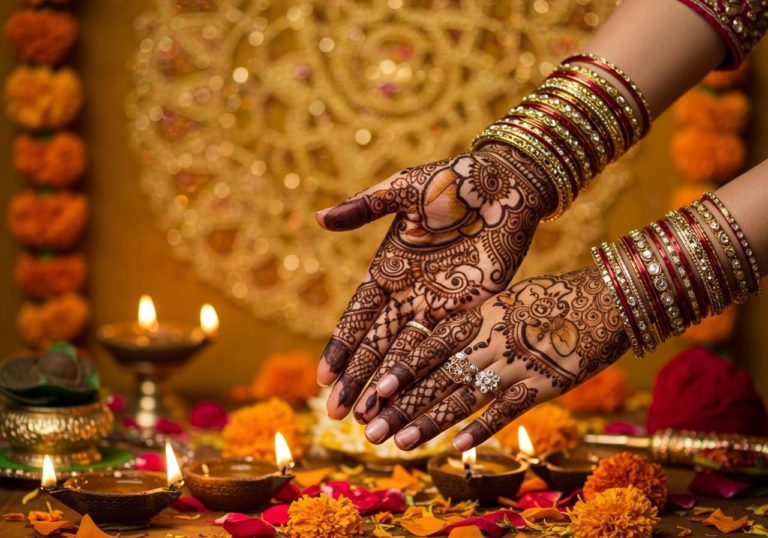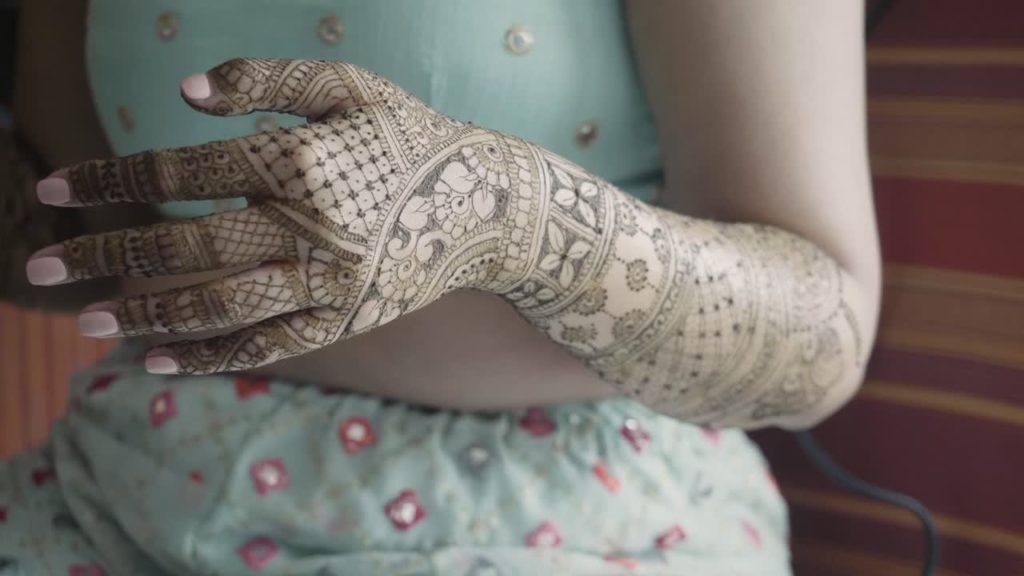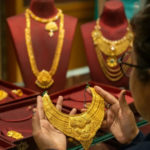- General
- Updated on August 5, 2025
Why Indian Women Apply Mehendi

Introduction
Indian Women Apply Mehendi not just as decorative art, but as a tradition steeped in cultural, spiritual, and symbolic meaning. For centuries, it has marked weddings, festivals, and religious ceremonies with its intricate patterns and deep significance. The sight of mehendi-adorned hands and feet is a familiar hallmark of celebration in Indian households. But have you ever wondered why this practice remains so deeply rooted in Indian culture?
In this blog, we explore the traditional and modern reasons behind mehendi application, shedding light on what makes it such an important part of Indian womanhood.
A Cultural Legacy Passed Through Generations

People in India have used mehendi for over 5,000 years, as ancient Vedic texts reveal. Communities in desert regions like Rajasthan and Gujarat initially valued it for its cooling properties. Over time, they transformed its use from a practical remedy into a deeply symbolic tradition. Today, families pass down the ritual of applying mehendi through generations, connecting daughters with their mothers and grandmothers through shared experiences and cherished stories.
During festivals like Karva Chauth, Teej, Diwali, and especially weddings, women gather in groups to apply mehendi—often accompanied by music, laughter, and sweets. It’s not just an act of beautification but a communal bonding experience.
Symbol of Love and Prosperity in Marriages
Among the most well-known associations of mehendi is its significance in Indian weddings.Family and friends adorn the bride’s hands and feet with elaborate designs a day or two before the ceremony during a special event known as the Mehendi ceremony. This act isn’t merely cosmetic—many believe that the darker the color of the mehendi, the deeper the love between the couple.
People also regard mehendi as a symbol of prosperity and fertility. Loved ones advise the bride not to wash it off but to let it fade naturally, as they believe the longer the color lasts, the more auspicious it is for her marriage.
Spiritual and Medicinal Beliefs
In traditional Indian wellness systems such as Ayurveda, mehendi (henna) is much more than decorative body art—it is valued for its natural healing and cooling properties. Ayurveda, which emphasizes balance and harmony within the body, considers mehendi a therapeutic herb that can help soothe both the physical and emotional self. People apply mehendi paste to the hands and feet—areas rich with nerve endings and vital points—to reduce internal body heat. This practice offers particular benefits in India’s warm climate or during times of physical or emotional stress.
People especially seek mehendi’s cooling effect during emotionally charged occasions like weddings, where anxiety and excitement often run high. Its calming influence helps ease nervous tension and lower stress levels, allowing brides and guests to maintain composure throughout the celebrations. Beyond relaxation, traditional practitioners believe mehendi may prevent common ailments such as headaches and fevers, which they often link to excess heat or imbalances within the body.
From a spiritual perspective, mehendi is imbued with significance that transcends physical healing. People consider mehendi a symbol of good fortune and protection, and they often apply it during auspicious occasions to ward off negative energies and evil spirits.
In many Indian households, the application of mehendi is accompanied by prayers and blessings, reinforcing its role as a sacred act that safeguards the wearer.
Because of these protective qualities, mehendi is not merely ornamental but also viewed as a spiritual shield—a practice meant to bring peace, prosperity, and positive energy into the life of the individual. This dual role, combining medicinal benefits with mystical protection, is part of what has kept the tradition alive and cherished through countless generations.
Religious Significance in Hinduism and Islam
In Hinduism, mehendi is far more than ornamental—it carries deep spiritual and religious meaning. It is commonly applied during important fasts and festivals, particularly those centered around goddess worship and marital devotion. For instance, during Teej, a festival that honors the divine union of Goddess Parvati and Lord Shiva, married women apply mehendi as a symbol of their devotion and prayers for marital bliss. It is believed that mehendi enhances the spiritual energy of the woman wearing it, connecting her with the divine feminine.
Another major occasion is Karva Chauth, a sacred fast observed by married Hindu women for the long life and well-being of their husbands. Applying mehendi is not just a beauty ritual during this festival—it’s a vital part of the prayer and devotion process. The designs are often intricate and meaningful, symbolizing fertility, love, and commitment. It is also said that mehendi strengthens the bond between couples and enhances the auspiciousness of the ritual.
In Islam, people value mehendi for both religious and cultural reasons. Muslim women frequently apply mehendi during Eid al-Fitr, Eid al-Adha, weddings, and family celebrations. They adorn their hands and feet with mehendi as a joyful and beautifying tradition that reflects the spirit of festivity and thankfulness. Importantly, the Prophet Muhammad (peace be upon him) recommended applying mehendi as a sunnah, encouraging its use for personal grooming and beautification.
In Islamic traditions, mehendi is also associated with purity and cleanliness, and it often marks new beginnings. Brides apply it as a part of their wedding rituals to welcome a new chapter of life with grace, happiness, and spiritual alignment. The act of applying mehendi becomes a moment of both celebration and religious mindfulness, bridging joy with sacred tradition.
Expression of Beauty and Creativity
While the roots of mehendi are deeply spiritual and cultural, it also serves as a creative outlet. Indian women take pride in the designs—ranging from traditional motifs like paisleys and peacocks to more contemporary styles incorporating initials, figures, and even miniature portraits.
Applying mehendi is often a moment of self-care and self-expression. Just like jewelry or makeup, it adds an elegant and celebratory touch to a woman’s appearance.
Mehendi in Modern Times: A Global Trend
Thanks to globalization and the rise of social media, mehendi has transcended cultural boundaries and made its way into mainstream fashion and beauty circles around the world. From Coachella music festivals to international fashion runways and even Hollywood red carpets, mehendi-inspired designs have gained popularity as a form of temporary body art. Artists and influencers across continents now experiment with henna patterns for their aesthetic appeal, showcasing them as chic, bohemian, or exotic additions to personal style.
This global embrace of mehendi reflects a growing appreciation for multicultural art and traditions. However, while the world may admire it as a fashion statement, for Indian women, mehendi continues to hold a much deeper meaning. It is not just about adornment—it is an emotional and symbolic ritual rooted in centuries of tradition.
For Indian women, the act of applying mehendi often marks a meaningful transition or milestone—be it a wedding, religious festival, pregnancy, or rite of passage. It becomes a moment of connection: to one’s culture, to family traditions, and often to other women in the community. Mothers pass down mehendi to their daughters, and women apply it during joyous pre-wedding ceremonies, weaving it into the very fabric of celebration and spirituality.
In essence, while the world may see mehendi as a beautiful art form, Indian women continue to view it as a living tradition—one that honors the past, celebrates the present, and brings blessings for the future.
Also Read: The Role of Fasting in Hindu Rituals and Festivals
Conclusion
The act of applying mehendi is a beautiful fusion of tradition, spirituality, and artistry. For Indian women, it’s not just about how the designs look—it’s about what they represent: love, protection, prosperity, connection, and joy. Whether done in a quiet moment of devotion or during a grand celebration, mehendi continues to be a cherished and meaningful tradition that transcends time.
Join the discussion
Related Articles
No results available
ResetTrending Articles


- General
- Updated on December 5, 2025


- General
- Updated on December 2, 2025


- General
- Updated on December 5, 2025


- General
- Updated on November 27, 2025


- Health
- Updated on November 24, 2025


- General
- Updated on November 24, 2025


- General
- Updated on November 19, 2025


- General
- Updated on November 19, 2025


- General
- Updated on November 14, 2025


- Tech
- Updated on November 12, 2025
No results available
Reset


